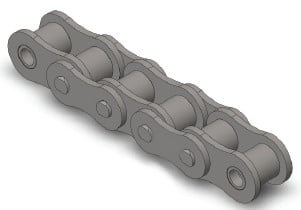The next methods must be applied to pick chain and sprocket sizes, figure out the minimal center distance, and calculate the length of chain required in pitches. We will mainly use Imperial units (such as horsepower) on this section however Kilowatt Capacity tables are available for each chain dimension within the preceding area. The selection approach will be the same irrespective of your units made use of.
Phase one: Establish the Class in the Driven Load
Estimate which on the following very best characterizes the problem in the drive.
Uniform: Smooth operation. Minor or no shock loading. Soft start out up. Reasonable: Usual or moderate shock loading.
Heavy: Serious shock loading. Frequent commences and stops.
Phase 2: Ascertain the Support Factor
From Table 1 beneath identify the acceptable Services Component (SF) for your drive.
Step three: Determine Style and design Energy Necessity
Design Horsepower (DHP) = HP x SF (Imperial Units)
or
Layout Kilowatt Electrical power (DKW) = KW x SF (Metric Units)
The Layout Power Requirement is equal for the motor (or engine) output electrical power occasions the Service Factor obtained from Table 1.
Phase four: Create a Tentative Chain Selection
Create a tentative variety of the expected chain size within the following method:
1. If making use of Kilowatt energy – fi rst convert to horsepower for this stage by multiplying the motor Kilowatt rating by one.340 . . . This is essential since the fast selector chart is proven in horsepower.
two. Locate the Style and design Horsepower calculated in stage three by reading through up the single, double, triple or quad chain columns. Draw a horizontal line through this value.
3. Locate the rpm of the modest sprocket to the horizontal axis with the chart.  Draw a vertical line by means of this value.
Draw a vertical line by means of this value.
4. The intersection in the two lines should indicate the tentative chain selection.
Stage 5: Decide on the number of Teeth to the Smaller Sprocket
As soon as a tentative choice of the chain dimension is made we have to determine the minimal amount of teeth necessary over the little sprocket required to transmit the Design and style Horsepower (DHP) or the Design and style Kilowatt Power (DKW).
Stage six: Decide the quantity of Teeth for the Big Sprocket
Make use of the following to calculate the amount of teeth for the large sprocket:
N = (r / R) x n
The amount of teeth about the big sprocket equals the rpm in the smaller sprocket (r) divided through the wanted rpm from the big sprocket (R) times the number of teeth around the compact sprocket. If the sprocket is too massive for the space obtainable then numerous strand chains of a smaller pitch need to be checked.
Step seven: Ascertain the Minimum Shaft Center Distance
Use the following to determine the minimum shaft center distance (in chain pitches):
C (min) = (2N + n) / 6
The above can be a guide only.
Step 8: Check the Last Variety
On top of that bear in mind of any probable interference or other area limitations that could exist and modify the variety accordingly. Generally probably the most efficient/cost eff ective drive uses single strand chains. This can be since various strand sprockets are far more high priced and as is usually ascertained through the multi-strand factors the chains grow to be much less effi cient in transmitting electrical power since the amount of strands increases. It really is therefore normally most effective to specify single strand chains every time doable
Step 9: Figure out the Length of Chain in Pitches
Use the following to determine the length on the chain (L) in pitches:
L = ((N + n) / two) + (2C) + (K / C)
Values for “K” could possibly be located in Table 4 on page 43. Keep in mind that
C is definitely the shaft center distance offered in pitches of chain (not inches or millimeters etc). In the event the shaft center distance is identified within a unit of length the value C is obtained by dividing the chain pitch (during the identical unit) by the shaft centers.
C = Shaft Centers (inches) / Chain Pitch (inches)
or
C = Shaft Centers (millimeters) / Chain Pitch (millimeters)
Note that each time attainable it really is finest to use an even quantity of pitches so as to stay clear of the usage of an off set hyperlink. Off sets usually do not possess the same load carrying capability as the base chain and ought to be averted if feasible.
The Drive Chain Choice Method
Tags
